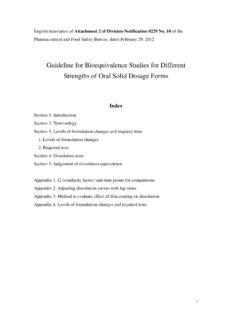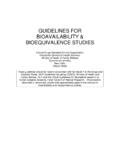Transcription of Appendix IV of the Guideline on the Investigation on ...
1 17 November 2011. EMA/CHMP/600958/2010/Corr.*. Committee of Medicines for Human Use (CHMP). Appendix IV of the Guideline on the Investigation on bioequivalence (CPMP/EWP/QWP/1401/98 ): Presentation of Biopharmaceutical and Bioanalytical Data in Module Draft agreed by Pharmacokinetics Working Party January 2011. Adoption by CHMP for release for consultation 17 February 2011. End of consultation (deadline for comments) 31 May 2011. Agreed by Pharmacokinetics Working Party November 2011. Adoption by CHMP 17 November 2011. Date for coming into effect 1 June 2012. Keywords generic applications, bioequivalence data, BCS biowaiver documentation, Standardised presentation, CHMP, EMA, Guideline *The correction concerns clarifications/corrections in Tables and 7 Westferry Circus Canary Wharf London E14 4HB United Kingdom Telephone +44 (0)20 7418 8400 Facsimile +44 (0)20 7418 8613.
2 E-mail Website An agency of the European Union European Medicines Agency, 2011. Reproduction is authorised provided the source is acknowledged. Appendix IV of the Guideline on the Investigation on bioequivalence (CPMP/EWP/QWP/1401/98 ): Presentation of Biopharmaceutical and Bioanalytical Data in Module Table of contents 1. Introduction .. 3. 2. Instructions for completion and submission of the tables .. 3. 3. A note about BCS-based biowaiver documentation .. 3. 2/10. 1. Introduction The objective of CTD Module is to summarize all relevant information in the MAA dossier with regard to biopharmaceutic studies and associated analytical methods. This Appendix contains a set of template tables to assist applicants in the preparation of Module providing guidance with regard to data to be presented.
3 Furthermore, it is anticipated that a standardized presentation will facilitate the evaluation process. The use of these template tables is therefore recommended to applicants when preparing Module This Appendix is intended for generic applications according to Directive 2001/83/EC, Article 10(1). Furthermore, if appropriate then it is also recommended to use these template tables in other applications such as variations, fixed combinations, extensions and hybrid applications. 2. Instructions for completion and submission of the tables The tables should be completed only for the pivotal studies, as identified in the application dossier in accordance with section of the bioequivalence Guideline (CPMP/EWP/QWP/1401/98 Rev.)
4 1). If there is more than one pivotal bioequivalence study, then individual tables should be prepared for each study. In addition, the following instructions for the tables should be observed: Details of non-EU reference products are not needed. Tables in Section 3 should be completed separately for each analyte per study. If there is more than one test product then the table structure should be adjusted. Tables in Section 4 should only be completed for the method used in confirmatory (pivotal). bioequivalence studies. If more than one analyte was measured then Table and potentially Table should be completed for each analyte. In general, applicants are encouraged to use cross-references and footnotes for adding additional information.
5 Fields that do not apply should be completed as Not applicable together with an explanatory footnote if needed. In addition, each section of the template should be cross-referenced to the location of supporting documentation or raw data in the application dossier. The tables should not be scanned copies and their content should be searchable. It is strongly recommended that applicants provide Module also in Word (.doc) or RTF format. 3. A note about BCS-based biowaiver documentation Relevant data for justification of BCS-based biowaiver requests should be included in Module "Comparative BA and bioequivalence (BE) Study Reports". A summary of the data should be provided in Module with a justification for the BCS-based biowaiver and a list of relevant references.
6 3/10. 1. BIOWAIVER REQUEST for DIFFERENT STRENGTHS. Table Qualitative and quantitative composition of the Test product. Ingredient Function Strength (label claim). XX mg XX mg XX mg (Production Batch (Production Batch (Production Batch Size) Size) Size). CORE Quantity per %* Quantity per %* Quantity per %*. unit unit unit TOTAL 100% 100% 100%. COATING. TOTAL 100% 100% 100%. *each ingredient expressed as a percentage (w/w) of the total core or coating weight or w/v % for solutions Instructions Include the composition of all strengths. Add additional columns if necessary. 4/10. Table In vitro dissolution data for biowaiver request. Dissolution testing Site Study Report Location <vol/page, link>.
7 Dissolution Conditions Apparatus RPM. Medium Volume Temperature Surfactant Collection Times (minutes or hours) f2. Dissolution Medium 5 10 15 20. Strength 1 pH=. # of units pH=. # Batch no pH=. QC medium1. Strength 2 pH =. # of units pH=. # Batch no pH=. QC medium1. Strength 3 pH=. # of units pH=. # Batch no pH=. QC medium1. 1. Only if the medium intended for drug product release is different from the buffers above Instructions Fill this table only if biowaiver is requested for additional strengths besides the strength tested in the bioequivalence study. Only the mean percent dissolution values should be reported but denote the mean by star (*) if the corresponding RSD is higher than 10% except the first point where the limit is 20%.
8 Expand the table with additional columns according to the collection times. If more than 3 strengths are requested then add additional rows. f2 values should be computed relative to the strength tested in the bioequivalence study. Justify in the text if not f2 but an alternative method was used. 5/10. 2. bioequivalence TRIAL INFORMATION. Table Test and reference product information Product Test Reference Characteristics product Product Name Strength Dosage form Manufacturer Batch number Batch size (Biobatch). Measured content(s)1 (% of label claim). Commercial Batch Size Expiry date (Retest date). Location of Certificate of <Vol/page, link> <Vol/page, link>.
9 Analysis Member State where the reference product is purchased from: This product was used in the <Study ID(s)> <Study ID(s)>. following trials: 1. List for each active substance for fixed combinations Instructions If more than one batch of the Test or Reference products were used in the bioequivalence trials then fill out Table for each Test/Reference batch combination. Table Study Site(s) of <Study ID>. Name Address EU Authority Inspection Year Authority Clinical Study Site Bioanalytical Study Site PK and Statistical Analysis Sponsor of the study 6/10. Table Study description of <Study ID>. Study Title: Report Location: <vol/page, link>. Study Periods Clinical: <DD Month YYYY> - <DD Month YYYY>.
10 Bioanalytical: <DD Month YYYY> - <DD Month YYYY>. Design Dose: Single/Multiple dose: Number of periods: Two-stage design: (yes/no). Fasting/ Fed: Number of subjects - dosed: <##>. - completed the study: <##>. - included in the final statistical analysis of AUC: <##>. - included in the final statistical analysis of Cmax: <##>. Instructions Fill out Tables and for each study. 3. RESULTS. Table Pharmacokinetic data for <analyte> in <Study ID>. 4. Arithmetic Means ( SD). Pharmacokinetic parameter Test Reference product Product AUC (0-t) 1. AUC (0- ) 2. Cmax tmax3. 1. AUC (0-72h) can be reported instead of AUC (0-t) , in studies with a sampling period of 72 h, and where the concentration at 72 h is quantifiable.














